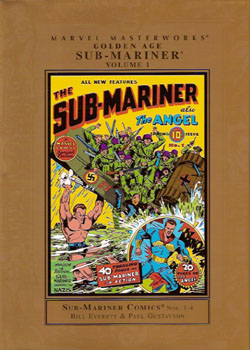
By Bill Everett, Paul Gustavson & others (Marvel)
ISBN: 0-7851-1617-6
After his dynamic relaunch in Marvel Comics #1 (soon to become Marvel Mystery Comics) and having first appeared in black and white in Motion Picture Funnies, Prince Namor, The Sub-Mariner, promptly gained his own title. Dated Spring 1941, that first issue featured two strips starring the hero/villain ruler of Atlantis as well as the costumed detective and adventurer The Angel in the first of a long run of macabre thrillers.
In the first tale the Sub-Mariner, hybrid offspring of a sub-sea Atlantean princess and an American polar explorer, goes to war against the perfidious Nazis when a fleet of German U-Boats depth-charges the underwater city. Namor retaliates in a bombastic show of super-power that perfectly displays the graphic virtuosity of creator Bill Everett.
The second story concerns a deadly disease afflicting his aquatic subjects which necessitates The Sub-Mariner’s return to New York to obtain – by any means necessary – a supply of Radium. The dual Hero/Villain nature of the character was always a major factor in Prince Namor’s popularity, and even a shared enemy couldn’t keep him on the good side of the American Authorities for long. These deluxe collections also include the mandatory text features that comics were compelled to include to keep their postal status (an arcane system that allowed them to procure large postal discounts as “second class mailâ€) so you can also enjoy ‘Namor… His Boyhood’ by Roy Gill before moving on to Paul Gustavson’s costumed detective in the 20 page gothic chiller ‘The Angel and the House of Horror’.
Although dressed like a superhero, this do-gooder was a blend of Leslie Charteris’s The Saint and The Lone Wolf (Louis Vance’s urbane two-fisted hero who was the subject of 8 books and 24 b-movies between 1917 and 1949), although his foes tended towards the spooky, the ghoulish and the just plain demented. He also seemed able to cast a giant shadows in the shape of an angel. Not the greatest aid to cleaning up the scum of the Earth but he seemed to manage. Dedicated fans should also note that this book reprints many of the original house ads for other comics the company were producing; and a very tantalising bunch they are.
Issue #2 (Summer 1941) starts off with another Nazi-busting tale (remember America was officially neutral until December 8th of that year) as Namor foils a scheme to spring thousands of German POW’s from internment in Canada. Everett’s hand is still in evidence but by this time an increasing number of assistants were slowly diluting his work as he struggled to produce a monthly strip in Marvel Mystery and his other commitments. The second adventure finds him in a Pennsylvanian town hunting fifth-columnists and spies who have fomented a strike amongst the miners producing coal for ships fuel. Cartoonist Lewis Glanzman provided a gag page and young Stan Lee a text feature entitled ‘The Story behind the Cover’ before The Angel quashed a sinister plot in New England to free ‘The Slaves of the Python’.
The Fall issue began with ‘The Mystery of the Disappearing Island’, a strikingly topical tale that includes Churchill, the question of Irish neutrality and a sub-sea city of druids captured by Nazis as a staging post for bomber raids. This exotic adventure, tinged with immediacy by political issues was an extra-long one (40 pages) followed by a mediocre prose tale ‘Dispatch from Africa’ and this issue closed with a rather incestuous murder mystery as the Angel hunts for a killer when ‘Death Draws a Comic Strip!’
The fourth issue begins with ‘Murders by Ghost Light’ as Namor investigates a haunted hospital, and continues a spooky theme when he encounters a giant monster in ‘The Horror that Walked.’ ‘Fresh Meat for a Raider’ is a prose naval adventure written by a young Mickey Spillane, and ‘Pop’s Woppers’ is a jolly gag feature from Art Gates followed by another spooky puzzler for the Angel: ‘Death’s Merry-Go-Round!’. The vintage thrills and laughs conclude with a lost gem from the legendary Basil Wolverton who wraps things up with a surreal Dr. Dimwit page.
Many early Marvel Comics are more exuberant than qualitative, but this volume, even if largely devoid of premiere league talent, is a wonderful exception and a reading as well as historical treasure that fans will find delightful.
©1941, 2005 Marvel Characters, Inc. All Rights Reserved.
